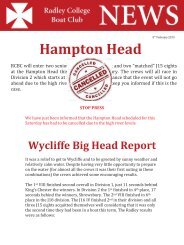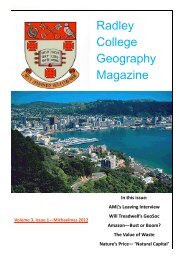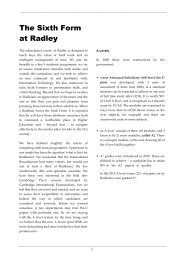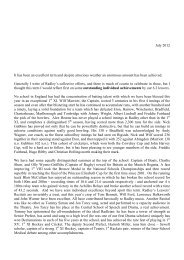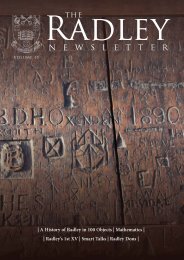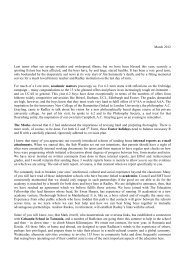INDEPENDENT SCHOOLS INSPECTORATE - Radley College
INDEPENDENT SCHOOLS INSPECTORATE - Radley College
INDEPENDENT SCHOOLS INSPECTORATE - Radley College
Create successful ePaper yourself
Turn your PDF publications into a flip-book with our unique Google optimized e-Paper software.
<strong>Radley</strong> <strong>College</strong> 1<br />
1. INTRODUCTION<br />
Characteristics of the School<br />
1.1 St Peter’s <strong>College</strong>, <strong>Radley</strong> was founded in 1847 by the Reverend William Sewell, Fellow of<br />
Exeter <strong>College</strong>, Oxford. <strong>Radley</strong> <strong>College</strong> – the name by which it is known – was incorporated<br />
by royal charter and is an all boarding, all boys school in the village of <strong>Radley</strong>, near Oxford.<br />
At the time of the inspection, the college had 644 pupils aged from 13 to 18, with 397 aged<br />
13 to 16 and 247 in the sixth form. Just over a fifth of pupils are in receipt of bursary or<br />
scholarship funding, almost all of which is from the college’s own resources. The college<br />
has eight boarding houses. Pupils come from different regions of the United Kingdom and<br />
some pupils’ families are based overseas. Pupils are from a wide range of family<br />
backgrounds, but mainly from the professions or business.<br />
1.2 <strong>Radley</strong> <strong>College</strong> was founded to provide an independent boarding school education on the<br />
principles of the Church of England. William Sewell intended the college to be different, to<br />
have a concern with “the aesthetic, good manners and kindness” and that philosophy still<br />
underpins the aims of the college.<br />
1.3 Since the last inspection, in May 2002, the college has built a theatre, a new pavilion and<br />
new kitchens. It is currently completing the building of two new boarding houses. It has<br />
developed its music and drama provision in a number of ways, including the foundation of a<br />
choristership scheme for local primary children. The college has reorganised its senior<br />
management team (SMT) and developed a pastoral committee to give greater oversight of<br />
pastoral care and pupil welfare. A foundation fund has been built up to support scholarships<br />
and building development.<br />
1.4 The main entry age for the college is thirteen. All prospective pupils sit the Common<br />
Entrance examinations or the <strong>Radley</strong> scholarship examination and a report is required from<br />
the feeder school of each applicant. The warden (headmaster) of the college reserves the<br />
right to interview any candidate for admission.<br />
1.5 Standardised tests in recent years indicate that the average ability of the pupils on entering<br />
the school at the age of thirteen is well above the national average. If pupils are performing<br />
in line with their abilities, their results in public examinations should be well above the<br />
average for all maintained schools but below the average for maintained selective schools.<br />
1.6 No pupil has a statement of special educational needs, but the college has identified 130<br />
pupils in need of learning support for learning difficulties or disabilities (LDD) which<br />
include dyslexia, dyspraxia and problems of retention and planning. All pupils are proficient<br />
in English. Most pupils are from preparatory schools or maintained senior schools. The<br />
overwhelming majority of pupils in Year 11 stay for the sixth form. On leaving Year 13, all<br />
proceed to university or higher education.<br />
1.7 The college’s expectation is that boys from a broad ability range will discover, and fulfil,<br />
their talents and will achieve outstanding academic results. The college aims to develop<br />
pupils’ character through a strong pastoral network, based on the boarding houses and on the<br />
daily influence of chapel. The college believes in the positive influences on pupils’<br />
development of the close-knit school community. It also aims to develop in its pupils the<br />
qualities of self-confidence, ease of personal communication, a firm grasp of what is right<br />
and wrong and an awareness of responsibility and concern for others.



